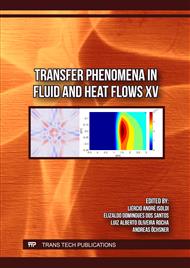[1]
C. Lee, H. Gil, H. Choi, S.H. Kang, Numerical characterization of heat transfer in closed-loop vertical ground heat exchanger, Sci. China Technol. Sci. 53 (2010) 111-116.
DOI: 10.1007/s11431-009-0414-8
Google Scholar
[2]
N. Soares, N. Rosa, H. Monteiro, J.J. Costa, Advances in standalone and hybrid earth-air heat exchanger (EAHE) systems for buildings: A review, Energy Build. 253 (2021) 111532.
DOI: 10.1016/j.enbuild.2021.111532
Google Scholar
[3]
A.S. Ramadan, Parametric study of vertical ground loop heat exchangers for ground source heat pump systems, Ph.D. Thesis, University of Western Ontario, Canada, 2016.
Google Scholar
[4]
J. Vaz, M.A. Sattler, E.D. dos Santos, L.A. Isoldi, Experimental and numerical analysis of an earth–air heat exchanger, Energy Build. 43 (2011) 2476-2482.
DOI: 10.1016/j.enbuild.2011.06.003
Google Scholar
[5]
G.C. Rodrigues, G. Lorenzini, L.C. Victoria, I.S. Vaz, L.A. Rocha, E.D. dos Santos, L.A. Isoldi, Constructal design applied to the geometric evaluation of a T-shaped earth-air heat exchanger, Int. J. Sustain. Dev. Plann. 16 (2021) 207-217.
DOI: 10.18280/ijsdp.160201
Google Scholar
[6]
M.K. Rodrigues, R. da Silva Brum, J. Vaz, L.A.O. Rocha, E.D. dos Santos, L.A. Isoldi, Numerical investigation about the improvement of the thermal potential of an Earth-Air Heat Exchanger (EAHE) employing the Constructal Design method, Renew. Energy 80 (2015) 538-551.
DOI: 10.1016/j.renene.2015.02.041
Google Scholar
[7]
M.K. Rodrigues, J. Vaz, L.A.O. Rocha, E.D. dos Santos, L.A. Isoldi, A full approach to Earth-Air Heat Exchanger employing computational modeling, performance analysis and geometric evaluation, Renew. Energy 191 (2022) 535-556.
DOI: 10.1016/j.renene.2022.04.007
Google Scholar
[8]
B.R. Nunes, M.K. Rodrigues, L.A.O. Oliveira Rocha, M. Labat, S. Lorente, E.D. dos Santos, C. Biserni, Numerical‐analytical study of earth‐air heat exchangers with complex geometries guided by constructal design, Int. J. Energy Res. 45 (2021) 20970-20987.
DOI: 10.1002/er.7157
Google Scholar
[9]
J. Xiao, Y. Hu, Q. Wang, J. Li, Structural design method, validation, and performance analysis of an earth-air heat exchanger for greenhouses, Geothermics 111 (2023) 102718.
DOI: 10.1016/j.geothermics.2023.102718
Google Scholar
[10]
A. Mathur, S. Kumar, Thermal performance and comfort assessment of U-shape and helical shape earth-air heat exchanger in India, Energy Built Environ. 3 (2022) 171-180.
DOI: 10.1016/j.enbenv.2021.01.002
Google Scholar
[11]
Z. Liu, Z.J. Yu, T. Yang, S. Li, M. El Mankibi, L. Roccamena, G. Zhang, Experimental investigation of a vertical earth-to-air heat exchanger system, Energy Convers. Manage. 183 (2019) 241-251.
DOI: 10.1016/j.enconman.2018.12.100
Google Scholar
[12]
C.L. Hwang, K. Yoon, Methods for multiple attribute decision making, in: Multiple Attribute Decision Making, Springer, Berlin, Heidelberg, 1981, pp.58-191.
DOI: 10.1007/978-3-642-48318-9_3
Google Scholar
[13]
I.S. Vaz, J. Vaz, L.C. Vitoria, L.A. Rocha, V.D. Hermes, E.D. dos Santos, M.K. Rodrigues, L.A. Isoldi, Numerical analysis comparing the thermal performance of vertical and horizontal earth-air heat exchangers, in: Proceedings of the 18th Brazilian Congress of Thermal Sciences and Engineering, ENCIT 2020, 2020.
DOI: 10.26678/abcm.encit2020.cit20-0286
Google Scholar
[14]
H. Schlichting, K. Gersten, Boundary-layer theory, Springer, 2016.
Google Scholar
[15]
B. Laudner, D.B. Spalding, Lectures in Mathematical Models of Turbulence, Academic Press, London, 1972.
Google Scholar
[16]
D.C. Wilcox, Turbulence modeling for CFD, DCW Industries, USA, 2002.
Google Scholar
[17]
D.W. Hahn, M.N. Özisik, Heat conduction, John Wiley & Sons, 2012.
Google Scholar
[18]
L.C. Victoria, V.F. Hermes, J. Vaz, J. Costi, W.C. Marques, L.A.O. Rocha, E.D. dos Santos, M.K. Rodrigues, C. Biserni, Methodology allying standard penetration test and Era-Interim data set for numerical simulations of Earth-Air Heat Exchangers, J. Adv. Res. Fluid Mech. Therm. Sci. 76 (2020) 43-64.
DOI: 10.37934/arfmts.76.2.4364
Google Scholar
[19]
R.S. Brum, J.V. Ramalho, M.K. Rodrigues, L.A. Rocha, L.A. Isoldi, E.D. dos Santos, Design evaluation of Earth-Air Heat Exchangers with multiple ducts, Renew. Energy 135 (2019) 1371-1385.
DOI: 10.1016/j.renene.2018.09.063
Google Scholar
[20]
V.F. Hermes, J.V.A. Ramalho, L.A.O. Rocha, E.D. dos Santos, W.C. Marques, J. Costi, L.A. Isoldi, Further realistic annual simulations of earth-air heat exchangers installations in a coastal city, Sustain. Energy Technol. Assess. 37 (2020) 100603.
DOI: 10.1016/j.seta.2019.100603
Google Scholar
[21]
D.S. Wilks, Statistical methods in the atmospheric sciences, International Geophysics Series, vol. 100, Academic Press, USA, 2011.
Google Scholar
[22]
S. Rehman, T.O. Halawani, Global solar radiation estimation, Renew. Energy 12 (1997) 369-385.
DOI: 10.1016/s0960-1481(97)00057-8
Google Scholar
[23]
A.L. Razera, R.J.C. da Fonseca, L.A. Isoldi, E.D. dos Santos, L.A.O. Rocha, C. Biserni, A constructal approach applied to the cooling of semi-elliptical blocks assembled into a rectangular channel under forced convection, Int. J. Heat Mass Transf. 184 (2022) 122293.
DOI: 10.1016/j.ijheatmasstransfer.2021.122293
Google Scholar
[24]
H.K. Versteeg, W. Malalasekera, An introduction to computational fluid dynamics: the finite volume method, Pearson Education, 2007.
Google Scholar
[25]
I.S. Vaz, S. Griebeler, M.K. Rodrigues, L.A.O. Rocha, E.D. dos Santos, L.A. Isoldi, Análise numérica de trocador de calor solo-ar vertical helicoidal, in: Proceedings of the 9th Conferência Sul em Modelagem Computacional, MCSul, 2022.
DOI: 10.14808/sci.plena.2015.081334
Google Scholar
[26]
Associação Brasileira de Normas Técnicas, ABNT NBR 16401-2:2008, Central and unitary air conditioning systems, Part 2: Thermal Comfort, ABNT, Rio de Janeiro, Brazil, 2008.
Google Scholar
[27]
American Society of Heating, Refrigerating and Air-Conditioning Engineers Inc., ASHRAE Handbook. Fundamentals - Chapter 8: Thermal Comfort, ASHRAE, Atlanta-GA, USA, 2005.
Google Scholar



